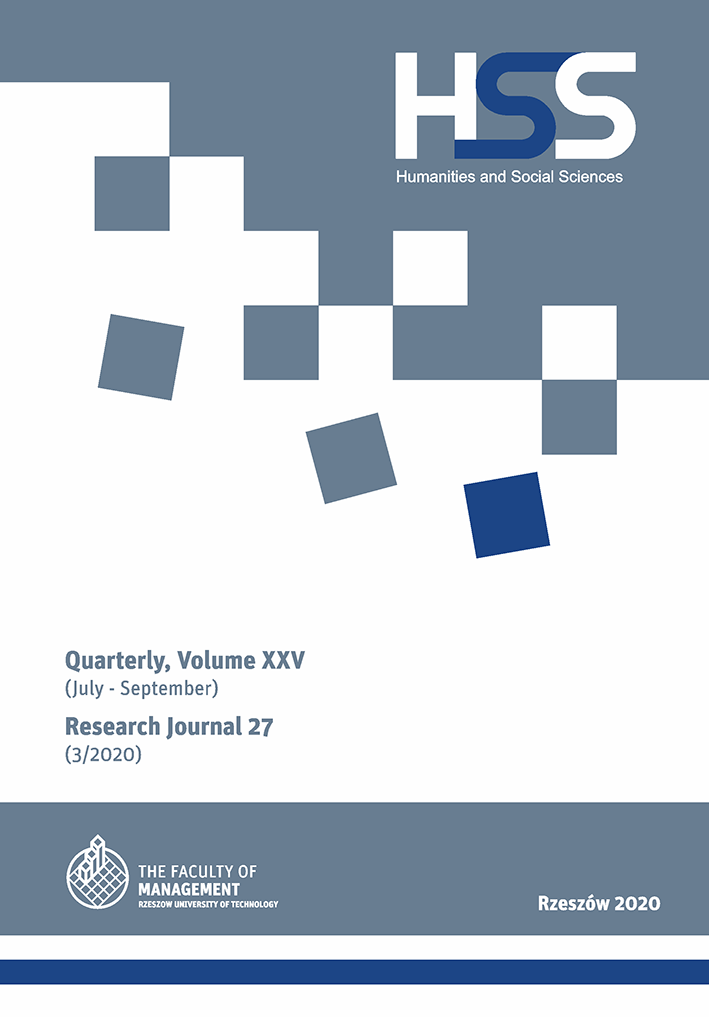Abstrakt
This paper, based on a master’s thesis, provides a definition, description and the importance of effective leadership within project management. The paper describes the principles for effective leadership within project management, the function of leadership and contrasts different leadership theories, as well as the effects of the different types of leaders in organizations. The paper provides an analysis of theories that dictate the effectiveness of leadership and how effective leadership in project teams influences a range of other variables. The paper utilizes the AHP method (hierarchical analysis process) to show the priority of management skills within a project management domain.
Bibliografia
A guide to the project management body of knowledge (PMBOK guide. Newtown Square, PA: Project Management Institute, 2017. Print.
Alexander, M. (2016). Lead or lag: linking strategic project management & thought leadership.
Bellingham, WA: Lead-Her-Ship Group.
Barker, Joel A., Scott W. Erickson (2005). Five regions of the future: the new paradigm for understanding technology. New York: Portfolio. Print.
Bennis, W.G. (2003). On becoming a leader. Cambridge. MA: Perseus Pub. Print.
BON. (2003). Organizational project management maturity model (OPM3): knowledge foundation. Newtown Square, Pa: Project Management Institute.
Chiocchio, François, E.K. Kelloway, Brian Hobbs (2015). The psychology and management of project teams: an interdisciplinary perspective. New York: Oxford University Press. Print.
Cobb, A. (2012). Leading project teams: the basics of project management and team leadership. Thousand Oaks, Calif: SAGE.
DeMarco, T. Lister, T. (1999). Peopleware: productive projects and teams. New York, NY: Dorset House Pub.
Drucker, P.T. (2017). What makes an effective executive. Boston, Massachusetts: Harvard Business Review Press Print.
Duhigg, C. (2012). The power of habit: why we do what we do in life and business. New York: Random House.
Ellis, C., Smith, J., Saw, M. (2016). The conscious project leader: how to create a culture of success for your projects, your team and yourself. Clifton Hill, Vic: Colin D Ellis.
Haugan, G. (2008). Work breakdown structures for projects, programs, and enterprises. Vienna, VA: Management Concepts.
Isaacson, W. (2014). Steve Jobs: lecciones de liderazgo. Barcelona: Debate.
Jenner, S., Kilford, C. (2011). Management of portfolios. Norwich: TSO (The Stationery Office.
Kerzner, H. (2005). Using the project management maturity model: strategic planning for project management. Hoboken, N.J: John Wiley & Sons.
Kerzner, H. (2006). Project management: a systems approach to planning, scheduling, and controlling. Hoboken, N.J: J. Wiley.
Kliem, R., Ludin, I., Robertson, K. (1997). Project management methodology: a practical guide for the next millennium. New York: Marcel Dekker.
Kouzes, J., Posner, B. (2007). The leadership challenge. San Francisco, CA: Jossey-Bass.
Lewis, J. (2003). Project leadership. New York: McGraw-Hill.
Malachowsky, S. (2018). Project team leadership and communication. Rochester, NY, USA: Lintwood Press. Managment (2011). Managing successful programmes. London: TSO (The Stationary Office).
Martínez, Eliseo, Salvador Rizo (1999). El Proyecto y su dirección y gestión. Valencia: Universidad Politécnica de Valencia, Servicio de Publicaciones. Print.
Maxwell, J. (2006). Las 21 leyes irrefutables del liderazgo. Nashville, TN: Lider Latino.
Mc Graw-Hill. (1996). McConell, S. Desarrollo y gestión de proyectos informáticos. Capítulo 11: Motivación.
McGregor, D. (1960). The human side of enterprise. New York: McGraw-Hill.
Michalko, M. (2006). Thinkertoys : a handbook of creative-thinking techniques. Berkeley, Calif: Ten Speed Press.
Palomo, M.T., Liderazgo y motivación de equipos de trabajo. Capitulo 2: La motivación. ESIC Editorial. 2000.
Miguel Ángel Sánchez Romero; Pablo Aragonés Beltrán; Mª Carmen González-Cruz; Juan Pascual Pastor Ferrando (2011). Cuestiones y Problemas Resueltos de Direccióin de Proyectos. Universitat Politécnica de Valéncia.
Peris Blanes, J., Jorge Alcaide Marzal, Monica Garcia Melon, Pastor, J.P., Gómez, T., Ferrer, P. Ferrero, G. (2002). Teoria y Proceso del Proyecto. Apuntes. Editorial UPV. SPUPV 2002.947.
PM. (2013). The standard for program management. Newtown Square, Pa: Project Management Institute.
Prince2 (2009). Managing successful projects with PRINCE2. London: TSO.
Prusak, A., Strojny, J., Stefanow, P. (2015). Zastosowanie metody AHP w badaniu satysfakcji klienta urzędu administracji publicznej [w:] Dziadkowiec, J., Sikora, T., red., Wybrane aspekty zarządzania jakością usług. Kraków: Uniwersytet Ekonomiczny w Krakowie.
Riepma, R., Hedeman, B., Aken, T. (2010). Projectmanagement voor het HBO op basis van IPMA-D. Zaltbommel: Van Haren Publishing.
Rocío Poveda Bautista; Gonzalez Cruz, Maria Carmen; Gomez-Senent Martinez, Eliseo (2007).
Fundamentos de la Dirección y Gestión de Proyectos. Universidad Politécnica de Valencia.
Rocío Poveda Bautista; Mª Carmen González Cruz; Eliseo Gómez-Senent Martínez (2008). Fundamentos de la Dirección y Gestión de Proyectos. LIMUSA S.A /Grupo Noriega Editores, de México
Roden, E., Vowler, S. (2013). Portfolio, programme and project offices. London: The Stationery Office.
Saaty, T.L. (1980). Multicriteria Decision Making: The Analytic Hierarchy Process. McGraw Hill. New York.
—— (1980). The analytic hierarchy process: planning, priority setting, resource allocation. New York London: McGraw-Hill International Book Co. Print.
Schmidt, T. (2009). Strategic project management made simple: practical tools for leaders and teams. Hoboken, N.J: John Wiley & Sons.
Somervill, B. (2009). Team projects. Chicago: Heinemann Library.
Strojny, J. (2009). Zarządzanie przedsiębiorczością w małej i średniej firmie. Rzeszów: Oficyna Wydawnicza Politechniki Rzeszowskiej.
—— (2019). Orientacja procesowo-projektowa organizacji samorządu lokalnego: wymiary, poziomy dojrzałości, determinanty oraz efekty w zakresie rozwoju lokalnego. Rzeszów: Oficyna Wydawnicza Politechniki Rzeszowskiej.
Strojny, J., Stankiewicz, B. (2009). Wielowymiarowa analiza przedsiębiorczości – metodologia, narzędzia i znaczenie dla społeczeństwa informacyjnego. „Przedsiębiorczość – Edukacja”, t. 5.
Strojny, J., Szulc, J., Baran, M. (2018). Applying the AHP Method into the Assessment of Project Attitudes.
Tracy, B., Pena, J. (2017). Liderazgo. Nashville, TN: Grupo Nelson.
TSO. (2015). PRINCE2 Agile. Norwich UK: TSO (The Stationery Office.
Webster, R. (2010). Management of risk: guidance for practitioners. Norwich: TSO (The Stationary Office).
Wong, Z. (2007). Human factors in project management: concepts, tools, and techniques for inspiring teamwork and motivation. San Francisco: Jossey-Bass.
Zandhuis, A. (2013). ISO 21500 : guidance on project management: a pocket guide.
Zaltbommel: Van Haren Pub. Kerzner, H. & Saladis, F. (2009). Value-driven project management. Hoboken, N.J: Wiley.


